Table of Contents
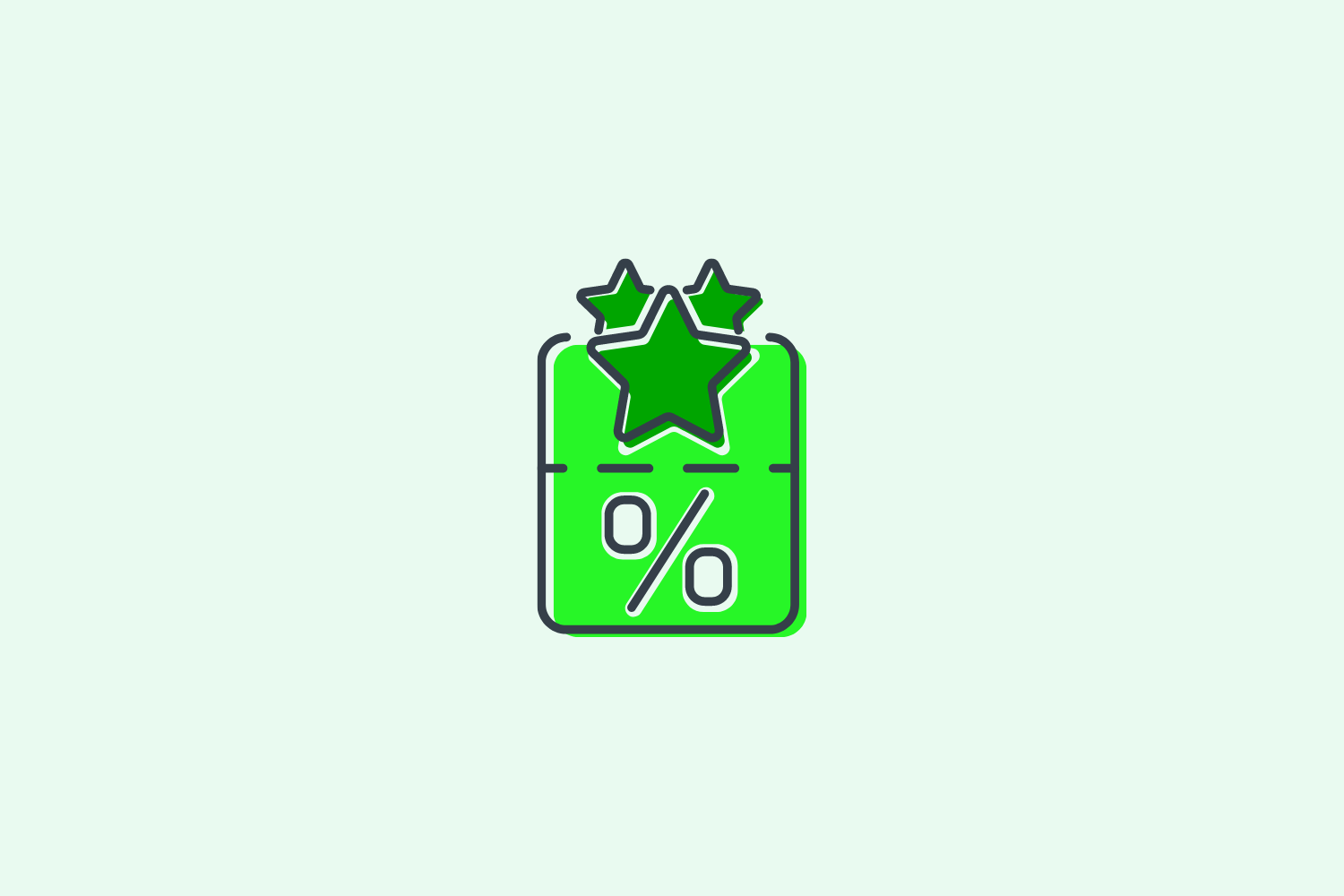
Key takeaways:
- Your customer retention rate tells you how many customers you’re retaining over set periods of time
- Most SaaS businesses can benefit from allocating more resources from acquisition to retention after the initial launch and growth phases
- SaaS companies can increase customer retention with a number of different strategies, including customer success programs and focusing on creating value
A lot of the reasons why customers cancel are actually avoidable. In fact, one survey found that companies in the U.S. lose $136 billion every year to avoidable customer switching.
So, how do you avoid churn and boost your customer retention rate? We’ve got plenty of advice to help you do exactly this.
Customer Acquisition vs. Retention
It’s widely accepted that acquiring new customers more expensive than retaining existing ones.
While SaaS companies do want to focus heavily on acquisition when they first launch, resource allocation should be equally divided between acquisition and retention once the company has moved beyond the initial launch and aggressive growth stages.
Yet, for some reason, the SaaS industry seems to be much more focused on customer acquisition than retention, despite the fact that SaaS companies need to keep customers long-term in order to grow.
Focusing primarily on acquisition makes sense in the early days, when you’re just starting to get off the ground. But as your business grows and you start to get new customers (and build a solid funnel to bring more in), you should really shift your focus towards retention.

No matter how many new customers you bring in each month, if you’re unable to keep them around long term, it’s extremely difficult to grow a SaaS business.
This can directly impact your net revenue retention and your net dollar retention, along with other key customer retention metrics.
You’ll find yourself in a never-ending cycle of trying to acquire new customers each month to replace the ones that are churning. It’s like spending more money than you make each month and trying to get out of debt.
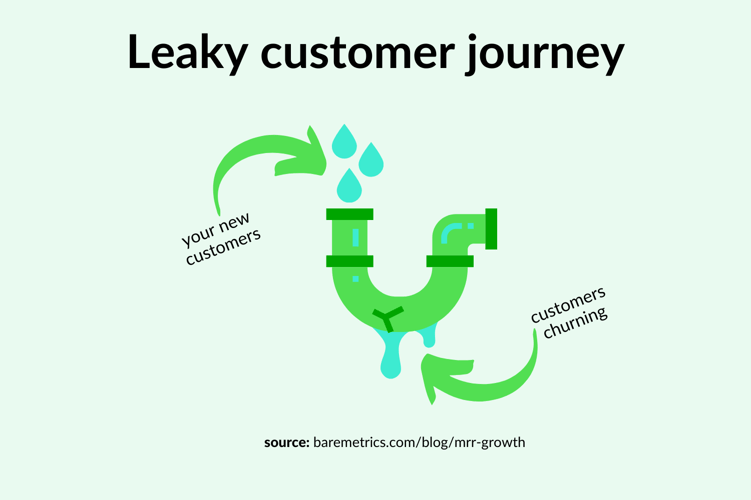
Coming from a customer acquisition background, I learned a lot about how impactful retention and upsells can be for SaaS companies once I joined Baremetrics.
Retention and expansion are a huge parts of our growth strategy.
In fact, you can see just how much of our revenue comes from existing customers versus new ones here.

Don’t get me wrong. I’m not saying that you should only focus on your existing customers.
But if you’re dedicating a large portion of your time and resources (like over 90%) solely on getting new customers, you might want to reconsider the mix. Especially if retention and churn have been an issue for you.
You can gain more insight into these metrics with a customer retention analysis.
How to Calculate Customer Retention Rate
First, decide what period of time you want to see your customer retention rate for. Typically it’ll be monthly or annually.
Then, you’ll need a few numbers:
- # of customers at the beginning of the period (B)
- # of customers at the end of the period (E)
- # of new customers gained during the period (N)
Then, you’ll just put those three numbers into the customer retention rate formula:
((E-N)/B) * 100
Here’s an example. Let’s say our numbers looked like this:
- 100 customers at the beginning of the period (B)
- 110 customers at the end of the period (E)
- 20 customers gained during the period (N)
If we put that into our formula, we get:
((110 – 20) / 100) * 100 = 90% retention rate
If you’re wondering where to get the initial numbers (B,E,N) you should be able to get them through your payment provider.
You can also find them in Baremetrics. You can grab the “B” and “E” under Active Customers.

Then you can get your “N” from the New Customers page.

Then, just plug those numbers into the formula, and you’ve got your customer retention rate.
Learn more about calculating retention rates to get started.
How to Improve Your Customer Retention Rate
Ideally, you want to keep your retention rate above 90%. If yours is under that, or you just want to get it as high as possible, let’s talk about iron-clad customer retention strategies to improve your numbers.
1. Discover Why Customers Are Churning
In order to retain more customers, you need to find out why they’re leaving in the first place. That means it’s time for a little churn analysis.
Churn analysis is using data to understand why customers churn. We wrote an entire guide on how to analyze churn to get you started.
But here’s a quick summary.
- Start by sending a cancellation survey to customers when they unsubscribe from your product; keep it short and to the point
- .Compile the data to look for common reasons customers churn
- Consider assessing churn rates by audience segments; some customers may feel that your product is too expensive, for example, while others don’t
Here’s an example of Baremetrics’ cancellation survey:
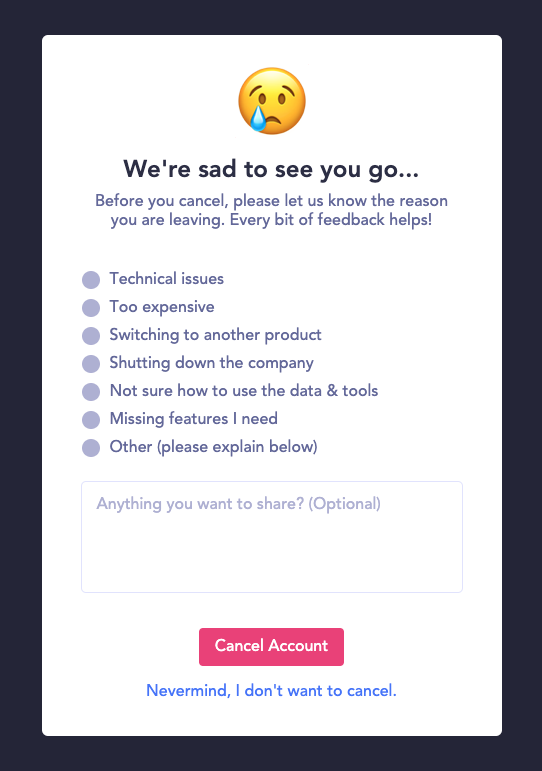
You can leverage Baremetrics’ Cancellation Insights (CI) tool for this. After filling out the survey, we collect the data and organize it in easy-to-read reports and dashboards like this:

This way, you can get an instant look at the top reasons people are cancelling, and how much revenue you’re losing from each cancellation reason.
Once you’ve identified the top cancellation reasons, you know exactly what’s hurting your retention rate. It could be pricing, a lack of a certain feature, poor support or anything else.
Prioritize the most common sources of lost revenue, or the most significant sources of lost revenue.
If you want to do some deep analysis, I recommend reading through the entire churn analysis guide. I dove into some very specific and more advanced strategies to analyze churn.
2. Track Retention by Customer Segment
Taking the previous tip one step further, you can add in a little cohort analysis. In Baremetrics, we show you your customer retention rate broken down by cohorts (based on when customers signed up). It looks like this.
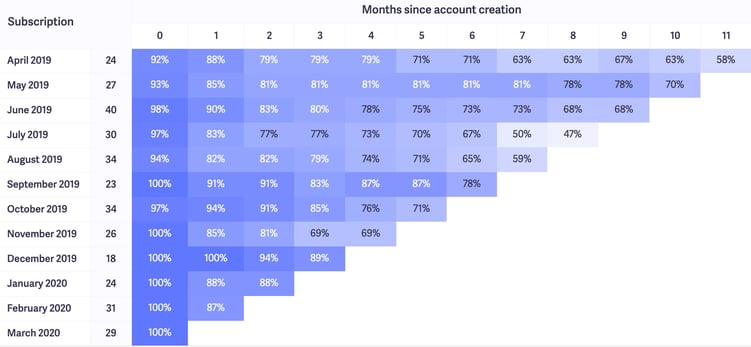
The percentages are the retention rates of each cohort month-to-month. For example, 79% of the 24 customers that signed up in April remained two months after signing up.
You can learn more in our cohort analysis guide.
You can do some pretty nifty things with this little table. I wrote about it all in our cohort analysis guide, which you can read here.
But the short of it is you can use it to spot trends, and zero in on what makes certain people churn over others.
For instance, if you notice your retention rate in months 0-3 are on the low end, there could be an issue with your onboarding process, or you’re acquiring the wrong type of customers.
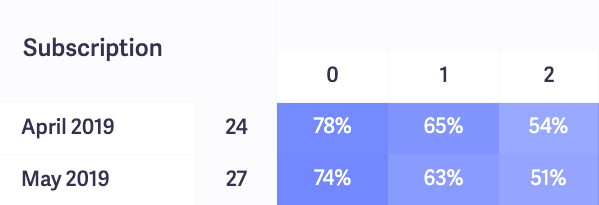
You can dive into their cancellation reasons (using tip #1) to learn exactly why these customers are cancelling so early on in their subscription.
If you want to see a step-by-step guide of how to do this, you can read my full guide here: How to Use Cohort Analysis to Reduce Churn & Improve Retention
3. Ask Customers How You Can Improve
You don’t need to wait until customers churn to find out where your product falls short. When is the last time you asked your current customers what you could improve on?
The easiest way to do this is by sending out a quick survey to your customers, like we did earlier this year.
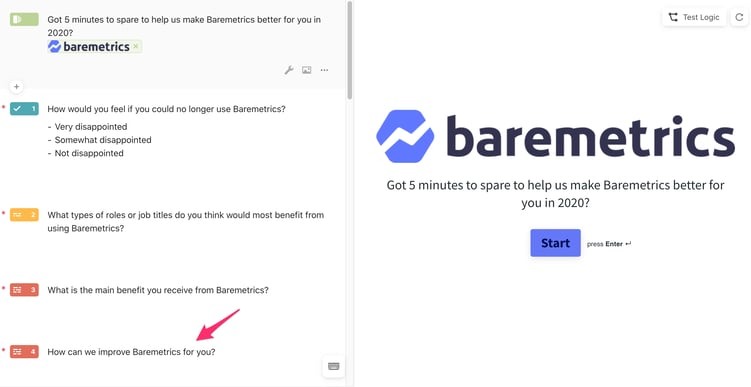
If you send a survey, just be prepared to handle all the comments without being defensive or dismissive.
Some of the feedback will be hard to hear (it’s almost like someone calling your baby ugly), but if you really take in the responses, it’ll help you retain more customers in the future.
Another way to get feedback is to monitor what people are saying about your brand on social media. People on Twitter seem to be particularly upfront about how they feel.
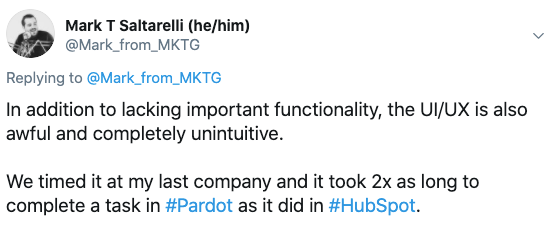
Gathering the feedback is step one. But unless you do something with the info, it’s not going to help your retention.
As you start to roll out the updates, keep an eye on your retention rate to see what type of impact it makes.
If you want to get really detailed, you can use our retention cohort table to see how the retention rate of customers that signed up during the months of your changes compare to previous ones.
4. Turn Customer Usage into a Routine
If you want to retain customers, make it so they can’t function without your product.
Easier said than done, I know. But it’s possible. In fact, you probably use a ton of apps and software right now that you couldn’t function without.
For instance, as a content marketer, one of the things I do on a daily basis is see what websites have linked to our site to find opportunities to partner up on content or just to send a quick email to say thanks.
Buzzsumo sends me a daily report of our backlinks from the day before, so it’s become a part of my regular workflow in the morning.
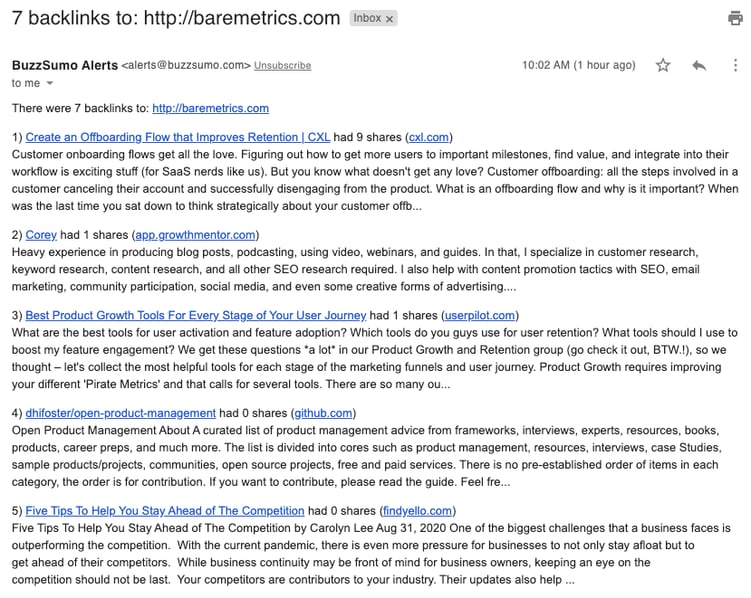
If I were to cancel my Buzzsumo account, it’d interrupt my daily schedule.
The ability to do something similar depends largely on your product, but there are plenty of examples to draw inspiration from.
The simplest way is to send notifications or alerts with some type of actionable/useful information like the Buzzsumo example. Over time, you’re training people to expect emails from you, to the point that it becomes a part of their day-to-day function.

So, the inconvenience of changing can be a motivator to retain users. Obviously, this isn’t something that should be abused. You don’t want people to keep using your product just because it’s a pain to stop using.
But if you make a product that customers can’t function without, it makes retaining them a lot easier.
5. Get Innovative & Spread the Word
You’ve probably heard the phrase “innovate or die” before. While it might sound a bit extreme, it’s a harsh reality for SaaS businesses.
No matter what type of software you sell, there are always competitors looking to create something better. And if you’re stuck in the past and refuse to make any notable changes to your product, customer retention is going to be a challenge.
A great example of this is Canva. It’s a visual editing tool that makes it easier for non-design savvy people (such as myself) to remove background from images, create professional looking graphics and images.
While Canva is probably the most well-known tool in the drag-and-drop design space, there are a ton of similar tools on the market.
That level of competition has forced Canva to either innovate or get beat out by the long list of competitors. So they’ve done things like add video/GIF creation, text effects, animated stickers and other updates to distinguish themselves.
But here’s where a lot of companies go wrong. They make big updates to their product, then just assume people will find out about them.
When you’re trying to boost retention, you need to take the initiative and make sure all your customers know about updates you make, even if you don’t think they’re a huge deal. Because even though the update might not seem major, it could be the thing that keeps a customer from cancelling.
We use Announcekit to let customers know when we release a new product update.
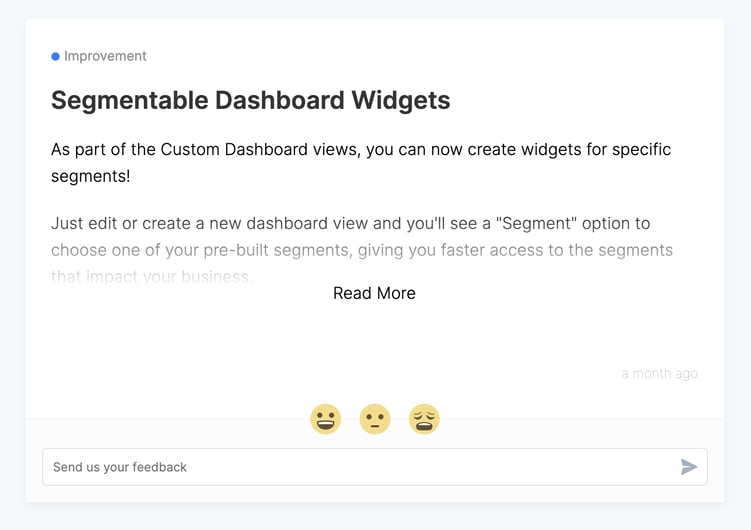
Some companies also post updates to their blog.
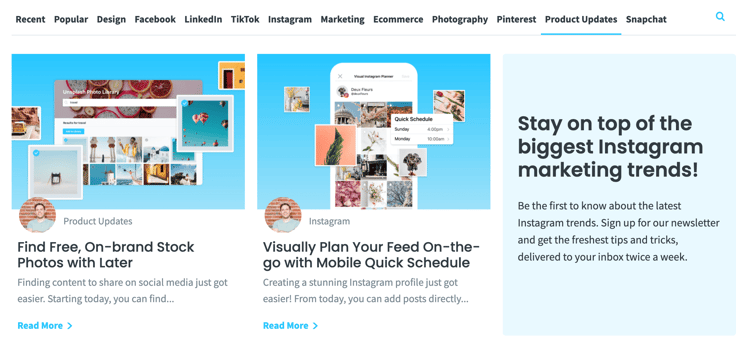
If you’re going to go the blog post route, follow in the footsteps of Mangools and send an email to your customers with a link to your article. Most customers don’t regularly check your blog just for fun.
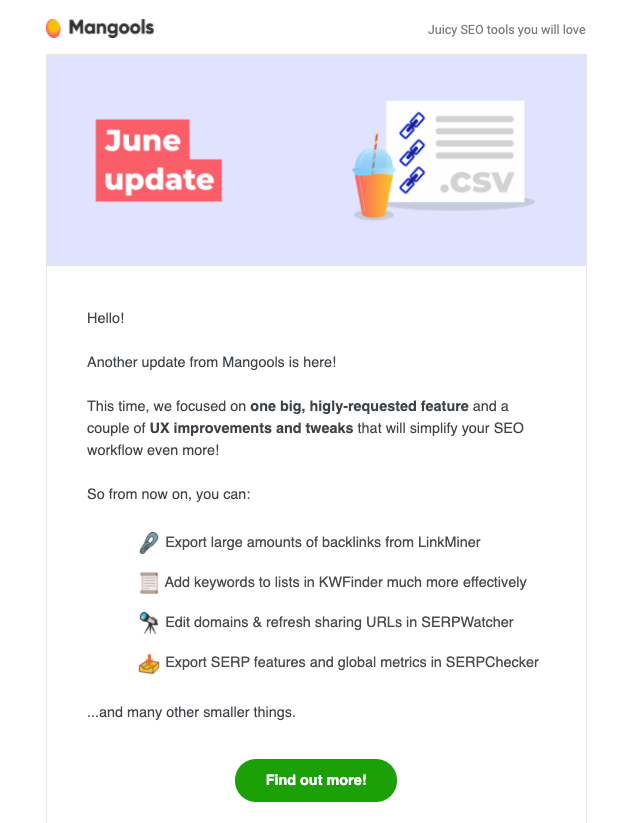
And if you’re not sure what product updates to do first, refer back to tips #1 and #2.
6. Create Valuable Content
You know the feeling of learning something new? The excitement you get when you learn a new skill and start to practice it over and over again. Or when you find out about a new restaurant, so you go back every week to try different dishes.
When you can create that feeling for your customers throughout their subscription, you have a much higher chance of retaining them.
You could keep releasing more and more product updates to try to capture that feeling. But product updates take time, and there’s only so many you can do on a frequent basis.
An easier and more efficient way to keep customers coming back to your product is to keep educating them on how to get more from it.
Whether it’s tips on how to use different features, unique use-cases or tactics they might not know about, product education is key for customer retention.
If you do it effectively, this type of content can work both for customer retention and acquisition.
It’s something we do with our content here at Baremetrics.
If you read some of our articles, like this one on reducing churn, you’ll notice that we include many tactics that show how to use Baremetrics.
The great thing about this approach is it acquires and retains customers.
It helps with the top-of-the-funnel acquisition because it shows people who’ve never used your product how it can be valuable to them. And it helps with retention because some of your current customers might not have thought to try the tactics you’re showing them.
Just make sure the content is useful and actionable for customers.
7. Create a Referral Program
When you incentivize and reward people, they tend to be more loyal to you. Just ask all the major airlines and credit card companies.
One of the best ways to reward customers and improve your retention rates is to create a referral program.
It’s a win-win situation. You get new customers through word of mouth, and your customers get rewarded with some type of incentive.
The incentive could be a discount on their monthly bill, free credits, or even money.
We even recently started our own referral program through Rewardful for our customers.
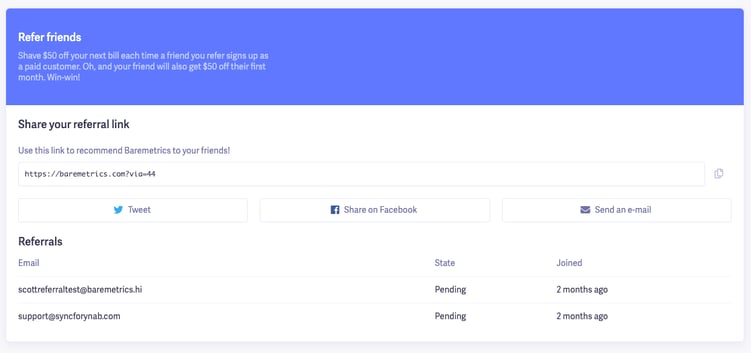
If you’re a Baremetrics user, you can check it out for yourself here.
There are plenty of other examples out there too. For instance, Typeform gives customers 10% off for each person they refer to a paid account. And it was a big part of their growth strategy.
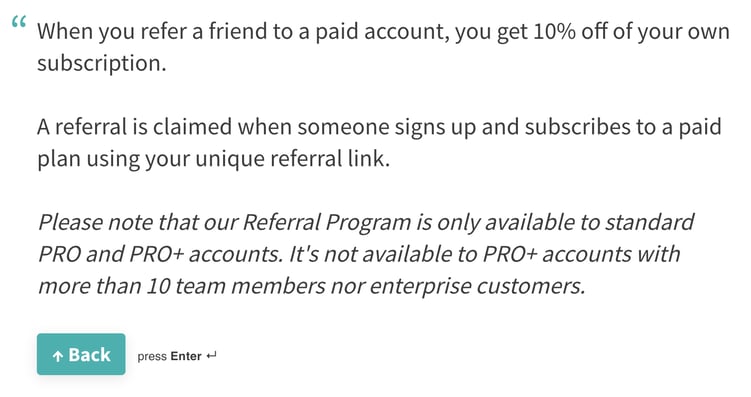
Since we’re pretty new to the SaaS referral game, I’ll refer you to this guide that goes in depth on how to start your own program.
Track & Optimize Your Customer Retention Rate with Baremetrics
Improving your customer retention rate will give you more revenue. so a “good” customer retention rate is important. But beyond the monetary reward, it also means people like your product. But beyond the monetary reward, it also means people like your product.
It’s important to choose strategies that will help you improve your customer retention rate, helping you to keep the customers you’ve worked so hard to acquire.
So, make it a priority to figure out how to keep your customers happy (and paying), and track the effect of your changes with Baremetrics!.
Tired of wasting time on spreadsheets? Get a free trial of Baremetrics today!




